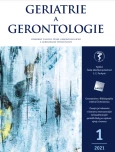How to determine cardiovascular risk in geriatric patients?
Authors:
Michal Vrablík
Authors‘ workplace:
3. interní klinika 1. LF UK a VFN, Praha
Published in:
Geriatrie a Gerontologie 2021, 10, č. 1: 31-34
Category:
Review Article
Overview
Stratification of cardiovascular (CV) risk in the age category 65–80 years is one of the important challenges of preventive cardiology today. Secondary prevention is not a problem in this regard, but we encounter difficulties in people in primary prevention. Although we have a number of scoring systems with which we can estimate CV risk, most of them are not suitable for geriatric patients. Recently, works calibrating the standard SCORE risk estimation system have been published for the mentioned age category. Calculators recommended and validated by the European Association of Preventive Cardiology (EAPC) collected at www.U-prevent.com can also be used to calculate the CV risk of the elderly. The choice of treatment strategies based on risk assessment is not yet as clear-cut as in younger patients. Therefore, in the elderly populations, the need to individualize the approach applies even more than in other patients.
Keywords:
elderly – cardiovascular risk – risk factors – prevention
Sources
1. Go AS, Mozaffarian D, Roger VL, et al. Heart disease and stroke statistics – 2013 update: a report from the American Heart Association. Circulation 2013; 127(1): e6–e245.
2. Perk J, De BG, European GH, et al. Guidelines on cardiovascular disease prevention in clinical practice (version 2012). The Fifth Joint Task Force of the European Society of Cardiology and Other Societies on Cardiovascular Disease Prevention in Clinical Practice (constituted by representatives of nine societies and by invited experts). Eur Heart J 2012; 33(13): 1635–1701.
3. Kaasenbrood L, Boekholdt SM, van der Graaf Y, et al. Distribution of estimated 10‐year risk of recurrent vascular events and residual risk in a secondary prevention population. Circulation 2016; 134(19): 1419–1429.
4. Briffa TG, Hobbs MS, Tonkin A, et al. Population trends of recurrent coronary heart disease event rates remain high. Circ Cardiovasc Qual Outcomes 2011; 4(1): 107–113.
5. Mahmood SS, Levy D, Vasan RS, Wang TJ. The Framingham Heart Study and the epidemiology of cardiovascular disease: a historical perspective. Lancet 2014; 383(9921): 999–1008.
6. Conroy RM, Pyorala K, Fitzgerald AP, et al. Estimation of ten‐year risk of fatal cardiovascular disease in Europe: the SCORE project. Eur Heart J 2003; 24(11): 987–1003.
7. Rodondi N, Locatelli I, Aujesky D, et al. Framingham risk score and alternatives for prediction of coronary heart disease in older adults. PLoS ONE 2012; 7(3): e34287.
8. Benetos A, Petrovic M, Strandberg T. Hypertension management in older and frail older patients. Circ Res 2019; 124(7): 1045–1060.
9. Benetos A, Bulpitt CJ, Petrovic M, et al. An expert opinion from the European society of hypertension European Union Geriatric Medicine Society Working Group on the Management of Hypertension in very old, Frail Subjects. Hypertension 2016; 67(5): 820–825.
10. van Bussel EF, Richard E, Busschers WB, et al. A cardiovascular risk prediction model for older people: Development and validation in a primary care population. J Clin Hypertens 2019; 21: 1145–1152.
11. Fried LP, Kronmal RA, Newman AB, et al. Risk factors for 5‐year mortality in older adults: the Cardiovascular Health Study. JAMA 1998; 279(8): 585–592.
12. Vrablík M, Piťha J, Blaha V, et al. Stanovisko výboru České společnosti pro aterosklerózu k doporučením ESC/EAS pro diagnostiku a léčbu dyslipidemií z roku 2019. AtheroRev 2019; 4(3): 126–137.
13. Cooney MT, Selmer R, Lindman A, et al. SCORE and CONOR investigators. Cardiovascular risk estimation in older persons: SCORE O.P. Eur J Prev Cardiol 2016 23(10): 1093–103.
14. Vliegenthart R, Oudkerk M, Hofman A, et al. Coronary calcification improves cardiovascular risk prediction in the elderly. Circulation 2005; 112(4): 572–7.
15. Rossello X, Dorresteijn JA, Janssen A, et al. Risk prediction tools in cardiovascular disease prevention: A report from the ESC Prevention of CVD Programme led by the European Association of Preventive Cardiology (EAPC) in collaboration with the Acute Cardiovascular Care Association (ACCA) and the Association of Cardiovascular Nursing and Allied Professions (ACNAP). Eur Heart J Acute Cardiovasc Care 2020; 9(5): 522–532.
Labels
Geriatrics General practitioner for adults Orthopaedic prostheticsArticle was published in
Geriatrics and Gerontology

2021 Issue 1
- Metamizole vs. Tramadol in Postoperative Analgesia
- Memantine in Dementia Therapy – Current Findings and Possible Future Applications
- Memantine Eases Daily Life for Patients and Caregivers
- Metamizole at a Glance and in Practice – Effective Non-Opioid Analgesic for All Ages
- Advances in the Treatment of Myasthenia Gravis on the Horizon
Most read in this issue
- Sarcopenic obesity: from the onset to interventions
-
Nutritional guidelines in geriatrics
The nutrition care process and screening - Mobility as a key factor for healthy ageing
-
The assessment of disability using WHODAS 2.0 tool at geriatric patients.
A pilot study WHODAS-GERI
